Weekly Market Commentary - March 23rd, 2022
The Markets
Markets were reassured by the Federal Open Market Committee (FOMC)’s actions last week.
The FOMC, the branch of the U.S. Federal Reserve System responsible for open market operations, met on March 16 and did exactly what most people expected them to do -- they raised the federal funds target rate by a quarter point. Federal Reserve Chair Jerome Powell said the Fed expects to continue to raise rates and reduce its balance sheet during 2022 to lower inflation.
The bond market appeared to give the Fed a vote of confidence. The yield on the two-year US Treasuries, which is the maturity that’s most sensitive to expectations for future rate hikes, rose from 1.75 percent at the end of last week to 1.97 percent. The yield on the benchmark 10-year US Treasuries also increased, but not by as much. North of the border, the Bank of Canada raised rates by 25 basis points at the beginning of the month, resulting in a similar rise in yields among Government of Canada bonds.
Randall Forsyth of Barron’s reported, “…moves in the Treasury market add up to a marked flattening in the slope of the yield curve, a classic signal the market foresees a slowing of real growth along with an eventual diminution of inflation pressures.”
In an ideal circumstance, central banks would engineer a “soft landing” by pushing demand for goods down just enough to quash inflation without causing the economy to go into recession. However, this has been made more difficult by the current conflict in Europe, as well as lingering supply chain problems caused by heavy-handed government policies at home and abroad.
Improved clarity around monetary policy reassured investors last week. Major stock indices rallied, with the S&P 500 index gaining 6.2 percent, the Dow Jones Industrial Average increasing by 5.5 percent, and the S&P/TSX Composite index rising a more modest 1.8 percent.
If you have any questions or concerns about your investment portfolio or current market conditions, please don’t hesitate to give us a call.

Source: FactSet
Survery corner:
Cycling Event (May/June 2022)
Special Events

Ride for Heart fundraiser

Watch our most recent videos:
Spring forward. Fall back.
This may be the mnemonic device you use to remember that clocks gain an hour in March and lose an hour in November, though most devices these days automatically account for daylight savings time.
The idea of daylight savings time was touted by Ben Franklin, but it didn’t really catch on until World War I, reported The Economist. At that time, Britain, France and Germany decided that adding an extra hour of daylight would reduce coal usage and help the war effort, so they moved clocks forward for several months.
Changing time isn’t popular today. A survey taken in the U.S. last November found that, overall, about six in 10 Americans would prefer not to have a time change, reported Kathy Frankovic of YouGovAmerica.
Last week, the U.S. Senate unanimously passed the Sunshine Protection Act, a bill that would make daylight savings time the new permanent 5 “standard time”. If the House of Representatives agrees the U.S. will have later sunsets all year round, beginning in 2023, with Canada likely to follow suit shortly after, assuming the Act is made law.
There may be economic advantages to adopting daylight savings time. Economists say that restaurants, retail stores and leisure businesses benefit from longer days, reported Angel Adegbesan of Bloomberg. There could be some disadvantages, too. Randyn Charles Bartholomew of Scientific American explained:
“Our wakefulness is governed by a circadian rhythm inside us linked to the solar cycle. Although many sleep researchers approve of ending the clock changes, they prefer the use of standard time… Less sunlight in the morning makes it harder for us humans to get started in the day, and more sunlight in the evening makes it harder to get to sleep. Darkness is a signal…that it’s time to start producing more melatonin, which is our body’s cue to lower internal temperature and start feeling sleepy. Early morning light…cause our bodies to stop melatonin production so we can feel wakeful throughout the day.”
That may be why making daylight savings time permanent was so unpopular the last time Congress did it, in the 1970s. The law was repealed after 16 months.
Spring forward. Fall back.
This may be the mnemonic device you use to remember that clocks gain an hour in March and lose an hour in November, though most devices these days automatically account for daylight savings time.
The idea of daylight savings time was touted by Ben Franklin, but it didn’t really catch on until World War I, reported The Economist. At that time, Britain, France and Germany decided that adding an extra hour of daylight would reduce coal usage and help the war effort, so they moved clocks forward for several months.
Weekly Focus - Think About It
“No man is an island, entire of itself; every man is a piece of the continent, a part of the main. If a clod be washed away by the sea, Europe is the less, as well as if a promontory were, as well as if a manor of thy friend's or of thine own were: any man's death diminishes me, because I am involved in mankind, and therefore never send to know for whom the bell tolls; it tolls for thee.”
—John Donne, writer and poet
Best regards,
Eric Muir
B.Comm. (Hons.), CIM®, FCSI
Portfolio Manager
Tracey McDonald
FCSI, DMS, CIM®
Portfolio Manager
Derek Lacroix
BBA, CIM®, CFP®
Associate Financial Advisor

